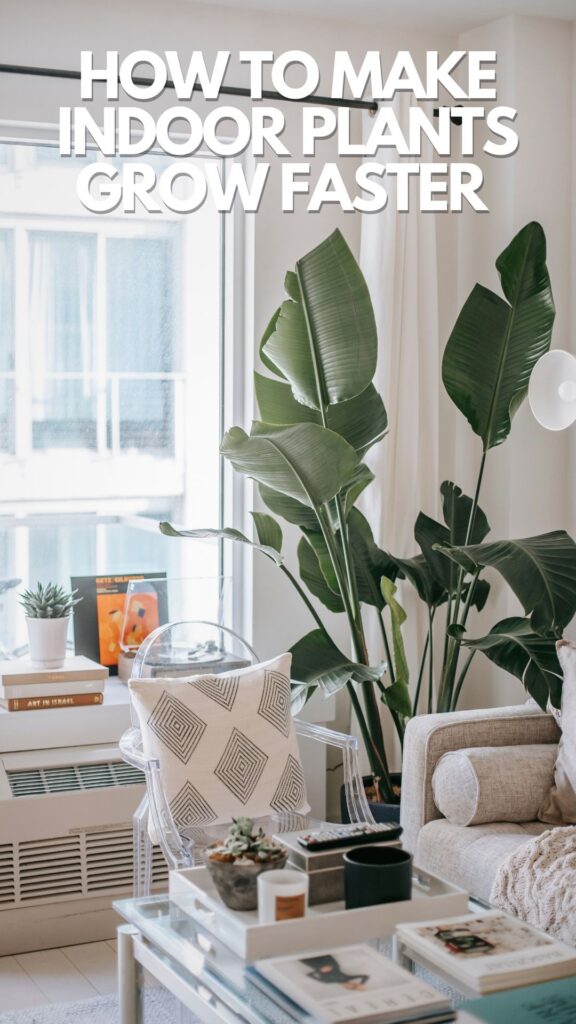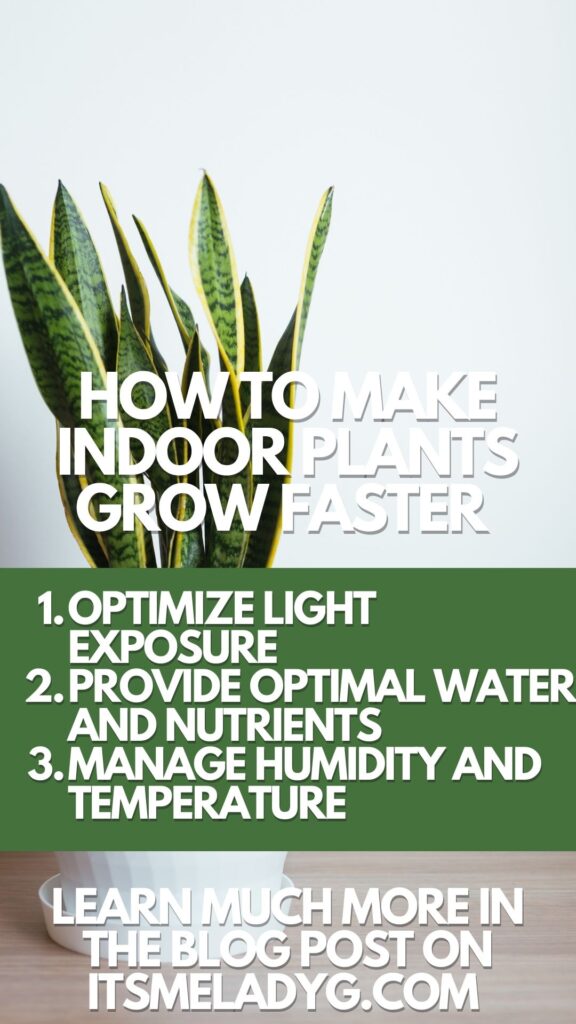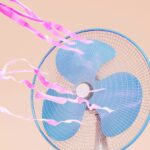Are you looking for ways to accelerate indoor plant growth? Indoor plants are a great way to bring life to any room. They not only add a pop of color but also provide numerous benefits such as purifying the air and reducing stress.

However, growing indoor plants can be a challenge, especially if you’re looking to speed up the process. Luckily, finding the best way to to ensure healthy plants for the most growth is shared in this blog post.
It’s important to note that different plants require different amounts of light, so it’s essential to research the specific needs of your plant based in their name.
FTC DISCLOSURE: Some of the links in this post are affiliate links. If you click on them and make a purchase, I will receive a small finder’s fee on the sale. This does not increase your price in any way shape or form. Using these links help support the continuation of this website. All opinions are my own. Thank you in advance.
Here are the best tips to accelerate indoor plant growth:
Optimizing Light Exposure
Indoor plants require sufficient light exposure to grow faster. In this section, we will discuss how to optimize light exposure for indoor plants. As a general rule, plants love sunlight or lights from a grow light. Whether your plant is a low light plant or a plant that needs a lot of light,
Natural Light
Natural light is the best light source for indoor plants. If you’re wondering what is bright light for plants, Direct sunlight is ideal for plants that require bright light. Indirect light is suitable for plants that require low light. The amount of light required by plants varies depending on the species. It is essential to understand the light conditions required by the plant species you are growing.
Giving your plants enough light is the most important thing you can do to increase healthy growth.
Foot candles are a unit of measurement used to determine the amount of light required by indoor plants. Most indoor plants require at least 1000 to 1500 foot candles of light to grow faster. However, some plants require more light than others. In general, or when in doubt, it’s always a good idea to give your plants bright indirect light at the minimum.
You Might Also Like Reading:
7 Best Soil Cover Ideas For Plants
Artificial Lighting
Artificial plant lights can be used to supplement natural light or replace it entirely. There are different types of artificial plant lights, including fluorescent lights, incandescent bulbs, and LED lights. LED lights are the most efficient and cost-effective type of artificial plant lights. Grow lights come in a lot of different types. It’s best to find the best that works with your budget, but this is a great light to start with.
I have also used and loved the Soltech Solutions light bulbs.
When using artificial plant lights, it is essential to ensure that the light source is close enough to the plant to provide sufficient light levels. The distance between the light source and the plant should be between 6 to 12 inches. The duration of light exposure should be between 12 to 16 hours per day.
Lastly, it’s best to get a grow light that fits your home style. This is why I like the Soltech Solutions grow lights so much.
Providing Adequate Water and Nutrients
One of the other most important factors used to get the best results from your plants is knowing how much water your indoor plants need. Indoor plants require adequate water and nutrients to grow faster. Providing the right amount of water and nutrients is crucial for healthy plant growth. In this section, we will discuss some watering and fertilizing techniques to help indoor plants grow faster.
Watering Techniques
Watering indoor plants is essential, but overwatering can be harmful. Overwatering can lead to root rot, which can kill the plant. In fact excess water is the most common cause of plants not surviving indoors. It is important to water indoor plants when the soil is dry. The frequency of watering depends on the type of plant, the size of the pot, and the humidity level.
One way to check if the plant needs water is to stick your finger in the soil. If the soil feels dry, it is time to water the plant. Another way to check is to lift the pot. If it feels light, it is time to water the plant.
You can also use terracotta self watering spikes for your plants. They are a great option for smaller plants especially if you forget to water your plants.
What’s the best way to water houseplants?
Watering indoor plants from the top can lead to waterlogging, which can damage the leaves and stems. It is recommended to water indoor plants from the bottom. Place the pot in a tray filled with water and let the soil absorb the water through the drainage holes. This way, the plant makes sure it has enough water.
Having a water meter is very helpful and takes a lot of the guesswork out of watering. Is you’re wondering what’s the best water to use to water your plants, there’s not one answer to that, I have used tap water for years and it works great.
Fertilizing Techniques
Fertilizing indoor plants is important to provide them with the necessary nutrients. There are different types of fertilizers available in the market, such as liquid fertilizer, granular fertilizer, and organic fertilizer.
Liquid fertilizers are fast-acting and provide quick results. They are easy to apply and can be mixed with water. Granular fertilizers release nutrients slowly and are long-lasting but water needs to added on top of it once they are sprinkled on the soil. Organic fertilizers are made from natural sources and are environmentally friendly. This is one of my favorite organic fertilizers. It has done well especially for my most fast growing plant.
It is important to follow the instructions on the fertilizer package. Over-fertilizing can damage the plant and lead to nutrient burn. Indoor plants require different nutrients at different stages of growth. Nitrogen is important for foliage growth, phosphorus is important for root growth, and potassium is important for flower and fruit development.
In addition to commercial fertilizers, there are some natural ways to provide nutrients to indoor plants. Compost, manure, coffee grounds, and crushed eggshells are rich in micronutrients and can be used as fertilizers. Carbon dioxide is also important for plant growth, and it can be increased by opening windows or using a CO2 generator.
I like to add some fertilizer during the growing season and when I can notice new growth of plants in the for of new leaves.
Managing Humidity and Temperature
Humidity Control
Indoor plants require a specific level of humidity to grow properly. Too little humidity can cause dryness and wilting, while too much humidity can lead to mold growth and root rot. To manage humidity levels, consider using a humidity tray or a humidifier.
A humidity tray is a shallow tray filled with water that is placed under the plant’s pot. As the water evaporates, it creates a humid environment around the plant. A humidifier is another option that can be used to increase the humidity in the room.
Temperature Control
Temperature is another important factor that affects indoor plant growth. Most indoor plants prefer temperatures between 60-75°F (15-24°C). However, some plants have specific temperature requirements, so it’s important to research the specific needs of your plants. Temperature fluctuations can also cause stress to plants, leading to yellowing leaves and stunted growth. To maintain a consistent temperature, keep plants away from drafty windows or doors and avoid placing them near heating or cooling vents.
When trying to promote faster growth in indoor plants, it’s important to monitor both humidity and temperature levels to ensure that they are within the optimal range for healthy plant growth. By using a humidity tray or humidifier and maintaining a consistent temperature, you can create a healthy environment that promotes new leaf growth and a larger pot for your plant to thrive in.
Pruning and Maintenance
Indoor plants require proper care and maintenance to grow faster and healthier. Pruning is an essential aspect of plant maintenance that involves removing dead or diseased foliage, encouraging new growth, and maintaining the plant’s shape. In this section, we will discuss pruning techniques and pest control.
Pruning Techniques
How to Prune how your houseplants to encourage growth?
Pruning techniques vary depending on the type of plant and the desired outcome. Deadheading is a common technique that involves removing dead flowers or leaves to encourage new growth. For plants that grow tall, such as the Arrowhead Plant or Epipremnum Aureum, pruning the top can encourage lateral growth and make the plant bushier.
Another technique is pinching, which involves removing the tip of a stem to encourage branching and new growth. For plants like the Tradescantia Zebrina, pinching can help maintain the plant’s size and shape.
If you’re wondering whether you should cut off the dead leaves from your indoor plant, generally I would say yes.
Pest Control
Pests can be a significant problem for indoor plants, leading to stunted growth, drooping leaves, and root rot. Regular inspection of the plant’s leaves and stems can help detect pests early. Common pests include spider mites, aphids, and mealybugs.
There are several ways to control pests, including using insecticidal soap, neem oil, or introducing natural predators like ladybugs. Maintaining proper humidity levels and avoiding overwatering can also prevent pest infestations.
Choosing the Right Plants
What’s the best Plant Type for your home?
When choosing plants to grow indoors, it is important to consider the type of plant. Some plants require more light, water, and care than others. Here are some popular indoor plants to consider:
- Houseplants: These are plants that are commonly grown indoors, and they come in all shapes and sizes. Some popular houseplants include spider plants, snake plants, and peace lilies.
- Low-Light Plants: These plants thrive in low-light conditions and are perfect for rooms without much natural light. Some examples of low-light plants include pothos, snake plants, and ZZ plants.
- Fast-Growing Indoor Plants: If you want to see results quickly, consider growing fast-growing indoor plants. Some popular options include spider plants, pothos, and philodendrons.
- Outdoor Plants: Some outdoor plants can also be grown indoors, but they may require more care and attention. Examples include herbs, succulents, and ferns.
Plant Care
Once you have chosen the right type of plant, it is important to provide the proper care to help it grow faster. Here are some techniques to consider:
- Watering: Different plants require different amounts of water, so it is important to research the specific needs of your plant. Overwatering can be just as harmful as underwatering, so be sure to find the right balance.
- Light: Most plants require some amount of light to grow, but the amount can vary. Low-light plants can survive with minimal light, while others need direct sunlight. Be sure to research the specific light requirements of your plant.
- Fertilizer: Fertilizer can help plants grow faster, but it is important to use it correctly. Too much fertilizer can harm the plant, so be sure to follow the instructions carefully.
- Pruning: Regular pruning can help promote growth and keep the plant healthy. Be sure to research the specific pruning needs of your plant.
By choosing the right type of plant and providing the proper care, you can help your indoor plants grow faster and healthier.









